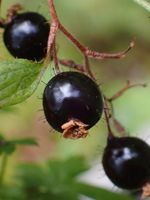Mon-Fri 9am - 5pm Mountain time
Bristly Black Currant vs Bilberry
Ribes lacustre
Vaccinium myrtillus
CUSTOM GROW
CUSTOM GROW
Bristly Black Currant is a native deciduous shrub that grows in moist forests, swamps, and riparian areas. In summer, it produces clusters of dark purple to black berries that provide food for wildlife, while its reddish-purple flowers attract pollinators. The berries are technically edible and enjoyed by some, but many find them unpleasant and bitter.
Thriving in moist soils and shaded locations, Bristly Black Currant helps stabilize soil and supports diverse habitats. It is valuable for conservation plantings, wetland restoration, riparian buffers, and naturalization projects.
Note: When crushed, the berries are known to release an offensive odour.
Bilberry is a native perennial shrub valued for its small, blue-black berries that ripen in mid to late summer. The berries resemble blueberries but have a richer, more tart, and intense flavor. They have long been used for fresh eating, baking, and preserves, while also providing food for birds and mammals. In spring, its delicate pinkish flowers attract bees and other pollinators.
Growing low to the ground, Bilberry forms spreading colonies that create dense understory cover. This growth habit provides food and shelter for wildlife, and its foliage adds seasonal interest by turning red to purple in autumn. With its adaptability and ecological benefits, Bilberry is well-suited for naturalization, ecological restoration, and pollinator gardens.

